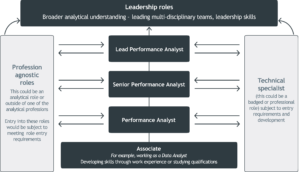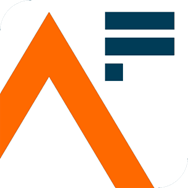Role profile: performance analyst
Performance analysts have strong data analysis skills. They develop performance measurement frameworks including:
- Key Performance Indicators (KPIs)
- goals
- user needs
- benefits
They analyse the performance of a service or product against these frameworks. Performance analysts will adapt their approach and frameworks as needed.
This role profile describes the role of a performance analyst from an analytical perspective. You can find out more about the skills needed to be a performance analyst in a digital team by reading the Digital, Data and Technology capability framework.
Typical role responsibilities
Performance analysts:
- work closely with stakeholders to help them decide what to measure
- define key performance measures drawing on quantitative and qualitative sources
- develop comprehensive performance frameworks to support the understanding of performance and help improve it
- analyse performance data to develop and test hypothesis relating to the design or operation of a service or product
- produce regular performance reports and dashboards to support stakeholder decision-making
- champion best practice in performance analysis, supporting others to improve the way they interpret data
- work to improve processes and systems referring to the Analysis Function Standards — for example, the Aqua Book
Skills
There are several important skills that performance analysts need to be successful in their role.
Find out more about skill level definitions.
You must:
- be able to turn data into valuable insights that inform decisions
- have an understanding of analytical tools and have good mathematical skills
As a performance analyst you will collect, organise, cleanse and interpret data to find meaningful and actionable insights. You must be able to identify and apply the most appropriate analytical techniques to:
- bring different data sources together
- tell a story with data
- challenge assumptions about data
You will be expected to demonstrate these skills at different levels depending on the seniority of your role.
Performance analyst
As a performance analyst, you must have a “practitioner” skill level.
Senior performance analyst
As a senior performance analyst, you must have an “expert” skill level.
Lead performance analyst
As a lead performance analyst, you must have a “practitioner” skill level.
You must:
- stay up to date with industry developments, and use new tools and technologies
- be aware of advances in analytics tools and data manipulation products
- be able to use coding and programming skills for data and analytics
You will be expected to demonstrate these skills at different levels depending on the seniority of your role.
Performance analyst
As a performance analyst, you must have a “practitioner” skill level.
Senior performance analyst
As a senior performance analyst, you must have an “expert” skill level.
Lead performance analyst
As a lead performance analyst, you must have a “practitioner” skill level.
You must be able to interpret requirements and present data in a clear and compelling way. This includes using graphical representations and data visualisations.
You will be expected to demonstrate these skills at different levels depending on the seniority of your role.
Performance analyst
As a performance analyst, you must have a “practitioner” skill level.
Senior performance analyst
As a senior performance analyst, you must have an “expert” skill level.
Lead performance analyst
As a lead performance analyst, you must have an “expert” skill level.
You must be able to choose and use the most appropriate method to:
- visualise data
- tell compelling and actionable stories about data relevant for business goals
You must be able to present, communicate and disseminates analysis and recommendations effectively and appropriately to a range of audiences.
You will be expected to demonstrate these skills at different levels depending on the seniority of your role.
Performance analyst
As a performance analyst, you must have a “working” skill level.
Senior performance analyst
As a senior performance analyst, you must have a “practitioner” skill level.
Lead performance analyst
As a lead performance analyst, you must have an “expert” skill level.
You must:
- be able to provide the intelligence to support both short-term and long-term strategic planning
- be able to identify and analyse options, and assess their feasibility and operational effects
- ensure that business solutions are aligned with strategy, business goals, and user needs
You will be expected to demonstrate these skills at different levels depending on the seniority of your role.
Performance analyst
As a performance analyst, you must have a “working” skill level.
Senior performance analyst
As a senior performance analyst, you must have a “practitioner” skill level.
Lead performance analyst
As a lead performance analyst, you must have an “expert” skill level.
You must be aware of quality assurance techniques. You must be able to:
- identify the right data sources
- validate the data
- understand how to interpret the results of analysis ensure data is fit for purpose
You will be expected to demonstrate these skills at different levels depending on the seniority of your role.
Performance analyst
As a performance analyst, you must have a “working” skill level.
Senior performance analyst
As a senior performance analyst, you must have a “practitioner” skill level.
Lead performance analyst
As a lead performance analyst, you must have a “practitioner” skill level.
Sample career pathway
The performance analyst career path shows some of the common entry and exit points in the role. It also shows the typical skill levels needed.
You can enter a performance analyst role from any profession, including other analytical professions. You can also exit the role to join another profession, including other analytical professions.
This career path aligns to the Digital, Data and Technology performance analyst role profile and skill levels.

The diagram shows a potential career path. It shows that you can enter or leave a role from a wide range of backgrounds and experience levels. For example, you could become a performance analyst by developing your skills in an associate role. You could continue to move up the levels in the career path by taking on more senior performance analyst roles. Or you could develop your skills by working in a technical specialist role in an analytical or digital profession. You could also develop the necessary skills by working in a profession agnostic role outside of these professions.
A role that could be done by any person with the relevant skills or experience from any profession.
This could be a ‘badged’ or professional role that is subject to entry requirements and development.
Beyond the lead performance analyst role, you could go into more senior leadership roles. These roles require broader analytical understanding, and the ability to lead multi-disciplinary teams.
